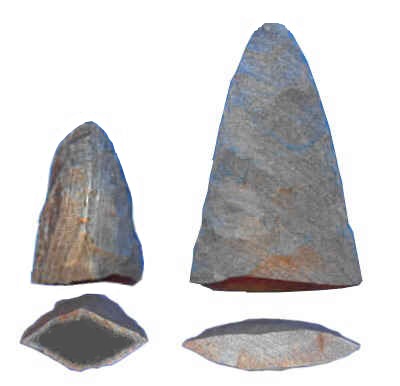| The story of two
tips: The Guilford tip on the left(circa 6,000-8,000 BP) and the Savannah River tip on the right(circa 3,000-4,000 BP) not only represent thousands of years of separation in their manufacture, they also have present day stories to tell. Both were found on the same housing project site which means this site is a multi-component site. It was inhabited by more than one generation of Native Americans. The point on the left is diagnostic of the thick "atlatl" points representing the earlier forms found in the Carolinas. Later, as hunting styles changed, points generally became thinner. |
|
| The point on
the right is believed to have served mostly as a knife form used on a short handle to cut
the flesh away from bone and hide. Both points are made of the same material, Rhyolite. Notice the dark center of the point on the left compared to the point on the right which center is the same color over the entire tip. This means that the right point was broken in prehistoric times. It has the same "patina" over its entire surface. Patination is the slow process of oxidation in which the acids in the soil change the nature of the outer area of the stone causing it to be a different color than the interior. This means that when each of these points were originally made, they were nearly black, like the untarnished center. It also means that there is the basal end of the point on the left is still in the vicinity of the housing project because a piece of earthmoving machinery was the cause of the break. Occasionally (rarely) the other half of the point can be found on subsequent visits. |

